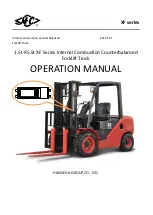
2100 SRM 103
Tilt Cylinder Repair
General
This section has a description and the repair proce-
dures for several different types of tilt cylinders. The
number and the design of the parts can be different,
but the operation of the tilt cylinders is the same.
Description
The tilt cylinders (Figure 2, Figure 3, Figure 4, and
Figure 5) are used to move the mast forward and
backward. To extend the cylinder rod (tilt forward),
oil enters the tilt cylinder port behind the piston. The
oil pressure pushes the cylinder rod out of the cylin-
der. Oil in front of the piston returns to the hydraulic
tank. To retract the cylinder rod (tilt backward), the
oil enters the port in front of the piston. The oil pres-
sure pushes the cylinder rod into the tilt cylinder.
The oil behind the piston returns to the hydraulic
tank.
Tilt Cylinder Repair
REMOVE
WARNING
Before removing the tilt cylinder(s), tilt the
mast forward. Use a chain to hold the mast to
the frame, and prevent the mast from moving
forward.
1.
Disconnect the hydraulic lines at the tilt cylinder.
Install caps on the hydraulic lines and ports.
WARNING
Do not push the anchor pins out of the rod end
with your fingers. Do not permit the tilt cylin-
ders to drop and cause damage.
2.
Remove the retainers for the anchor pins. Push
the anchor pins out of the rod end with a tool.
3.
Use a lifting device to move large tilt cylinders.
Remove the anchor pins from the frame anchors.
Remove the tilt cylinder from the frame.
DISASSEMBLE
1.
Put the tilt cylinder in a vise with soft jaws. Re-
move the rod end from the rod.
2.
Remove the retainer from the tilt cylinder. Re-
move the rod and piston from the cylinder.
3.
Disassemble the tilt cylinder as necessary. See
Figure 2, Figure 3, Figure 4, and Figure 5.
CLEAN
WARNING
Cleaning solvents can be flammable and toxic
and can cause skin irritation.
When using
cleaning solvents, always follow the solvent
manufacturer’s recommended safety proce-
dures.
Compressed air can move particles so that they
cause injury to the user or to other personnel.
Make sure that the path of the compressed air
is away from all personnel.
Wear protective
goggles or a face shield to prevent injury to the
eyes.
Clean all parts in solvent and dry with compressed
air.
1




























